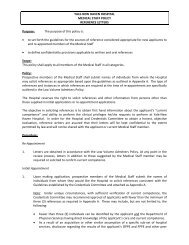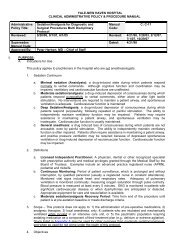Observers - Yale-New Haven Hospital
Observers - Yale-New Haven Hospital
Observers - Yale-New Haven Hospital
You also want an ePaper? Increase the reach of your titles
YUMPU automatically turns print PDFs into web optimized ePapers that Google loves.
4. Follow department-specific instructions.<br />
D. RADIATION ACCIDENTS:<br />
1. Phone "119" to report the spill / discovery of radioactive material - The Page Operator will sound the "Order<br />
Number One" and begin notification.<br />
2. Injured and possibly contaminated persons should be transported to the Emergency Department under the<br />
direction of the area supervisor.<br />
3. Evacuate the area under the direction of the most senior staff upon consultation with <strong>Hospital</strong>, University, and/or<br />
City personnel.<br />
4. Follow department-specific instructions.<br />
E. BIOLOGICAL ACCIDENT:<br />
1. Phone Epidemiology and Infection Control (8-4634) for initial detection - Epidemiology and Infection Control<br />
will notify Administration and others.<br />
2. Assist with patient care as directed by area supervisor, <strong>Hospital</strong> Epidemiologist/designee, etc.<br />
3. Use proper precautions as directed by <strong>Hospital</strong> Epidemiology and appropriate administrators.<br />
4. Follow department-specific instructions.<br />
OXYGEN SAFETY<br />
A. SAFE OXYGEN HANDLING AND STORAGE<br />
Oxygen gas is contained in traditional green, 30 lb. steel tanks or cylinders. As oxygen is a hazardous chemical, each tank<br />
MUST be labeled. All gases for medical use are contained in color-coded tanks; however ALWAYS READ THE LABEL and<br />
confirm that the tank you are going to use does contain oxygen.<br />
Oxygen tanks that are considered “in use” (regulator attached) should be stored in a rack that is secured to a wall or carrier in<br />
an upright position with the regulator off. If an oxygen tank is empty or not in use it must be stored in the “Oxygen Tank<br />
Storage Cabinet” that is found in all patient care areas. Oxygen tanks should never be stored lying down. If the tank is stored<br />
with the regulator and/or flow meter attached, make sure both the regulator and flow meter are turned OFF. AN OXYGEN<br />
TANK MUST BE STORED WITH THE VALVE CLOSED.<br />
B. OXYGEN AND FIRE DANGER<br />
An intentional oxygen shut-off should only happen in the event of a major fire emergency or leak in the system. While oxygen<br />
itself is not flammable or explosive, it will feed a fire and cause it to burn hotter and faster. If you discover a fire in a patient<br />
room, shut off the oxygen at the wall (turn off the flow meter), if possible. If you are unable to do this, rescue the patient from<br />
the room (activate the “R.A.C.E.” protocol), and call for the patient’s nurse and a Respiratory Therapist.<br />
ONLY A RESPIRATORY THERAPIST AND/OR PLANT ENGINEERING PERSONNEL SHOULD SHUT OFF THE FLOOR<br />
OR ZONE OXYGEN AFTER ASSESSING THE CONSEQUENCES. Patients requiring oxygen will need to be connected to<br />
portable oxygen. Emergency Oxygen Shut-off valve(s) are located on all floors, usually close to the entrance to the floor/unit;<br />
it is unit-specific. NEVER BLOCK ACCESS TO THE EMERGENCY OXYGEN SHUT-OFF VALVE. Some emergency oxygen<br />
shut-off valves turn the flow of oxygen off to the entire floor; others will only cause the oxygen to stop in certain areas or zones<br />
of a patient care area. Each emergency oxygen shut-off valve is marked with the area it services. In the normal open<br />
position of the emergency oxygen shut-off valve the handle is parallel to the pipe.<br />
In the event of a Code 5 or Code 7 on a ventilated patient remember to TURN THE VENTILATOR OFF BEFORE<br />
DEFIBRILLATING OR USING OTHER ELECTRICAL EQUIPMENT. The ventilator will continue to supply concentrated<br />
oxygen into the area. Use of electrical equipment in this instance may cause a fire and potential bodily harm to the patient and<br />
others.<br />
RADIATION SAFETY<br />
A. KEY SAFETY ELEMENTS






![Annual Report Donor Listings [pdf] - Yale-New Haven Hospital](https://img.yumpu.com/49673575/1/190x245/annual-report-donor-listings-pdf-yale-new-haven-hospital.jpg?quality=85)










